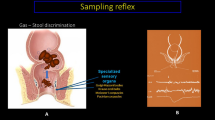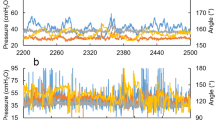Abstract
Background/Aim
We present 18 women who under normal conditions had fecal and flatus control. They leaked flatus only during coitus. We investigated the hypothesis that these women had a concealed anal sphincteric disorder.
Methods
Eighteen multiparous women (mean age 44.8 ± 7.2 SD years) complained of involuntary passage of flatus during coitus of 4.6 ± 2.4 years duration. Mean deliveries amounted to 8.2 ± 2.1, of which 5.2 ± 1.1 were by forceps. Patients had neither fecal nor flatus incontinence except during coitus. Nine healthy volunteers matching patients in age and number of deliveries but without coital passage of flatus were included in the study. Monitoring comprised anorectal pressure studies and external and internal anal sphincter (EAS, IAS) electromyography (EMG). Plain X-ray and barium enema studies were done to detect stools in the rectum.
Results
The rectal and anal pressures at rest and on voluntary squeeze of the patients matched those of the healthy volunteers. The recto-anal inhibitory reflex (RAIR) in the patients was abnormal; it recorded on rectal contraction a significantly lower anal pressure than that of the healthy volunteers; also, the rectal contraction occurred at a volume lower than with the volunteers. The EAS EMG of patients was normal, while their IAS EMG recorded a significantly lower activity at rest and on rectal distension than those of volunteers. Stools were detected at rest in the rectum of all patients and in only two of the volunteers.
Conclusions
The distal end of the erect penis seems to buffet the lower rectum at coitus. In patients, the abnormal RAIR, the diminished IAS EMG as well as the presence of stools in the rectum at rest appear to be responsible for passage of flatus at coitus.




Similar content being viewed by others
References
Bannister JJ, Read NW, Donnely TC, Sun WM (1989) External and internal anal sphincter responses to rectal distension in normal subjects and in patients with idiopathic fecal incontinence. Br J Surg 76:617–621
Carlstedt A, Nordgren S, Fasth S, Appelgren L, Hulten L (1988) Sympathetic nervous influence on the internal anal sphincter and rectum in man. Int J Colorectal Dis 3:90–95
Denny-Brown D, Robertson EG (1935) An investigation of the nervous control of defecation. Brain 58:256–310
Gagnard C, Godlewski G, Prat D, Lan O, Cousineau J, Maklouf Y (1986) The nerve supply to the external anal sphincter: the macroscope supply and microscopic structure. Surg Radiol Anat 8:115–119
Goligher JC (1984) Surgical anatomy and physiology of the anus, rectum and colon. In: Goligher JC (ed) Surgery of the anus, rectum and colon, 5th edn. Ballière Tindall, London, p 40
Govan ADT, Hodge C, Callander R (1985) The vagina. In: Govan ADT, Hodge C, Callander R (eds) Gynecology illustrated, 3rd edn. Churchill Livingstone, Edinburgh, pp 26–28
Holmes AM (1961) Observations on the intrinsic innervation of the rectum and anal canal. J Anat 85:416–422
Lubpwski DZ, Nicholls RJ, Swash M, Jordan MJ (1987) Neural control of internal sphincter function. Br J Surg 74:668–670
Mc Neil NI, Rampton DS (1981) Is the rectum usually empty? A quantitative study in subjects with and without diarrhea. Dis Colon Rectum 24:596–599
Rossolimo G (1891) Der Analreflex, seine Physiologie und Pathologie. Neurol Centralblatt 10:257–259
Shafik A (1987) A concept of the anatomy of the anal sphincter mechanism and the physiology of defecation. Dis Colon Rectum 30:970–982
Shafik A (1993) Recto-levator reflex. The description of a new reflex and its clinical application: preliminary report. Clin Physiol Biochem 10:13–17
Sum WM, Read NW, Prior A et al (1984) Sensory and motor responses to rectal distension vary according to the rate and pattern of balloon inflation. Gastroenterology 86:693–697
Wexner SD, Jorge JMN (1998) Anatomy and embryology of the anus, rectum and colon. In: Corman ML (ed) Colon and rectal surgery, 4th edn. Lippincott-Raven, Philadelphia, pp 1–26
Acknowledgment
Margot Yehia assisted in preparing the manuscript.
Author information
Authors and Affiliations
Corresponding author
Rights and permissions
About this article
Cite this article
Shafik, A., Shafik, I.A., El Sibai, O. et al. Flaturia: passage of flatus at coitus. Incidence and pathogenesis. Arch Gynecol Obstet 275, 33–37 (2007). https://doi.org/10.1007/s00404-006-0218-z
Received:
Accepted:
Published:
Issue Date:
DOI: https://doi.org/10.1007/s00404-006-0218-z




